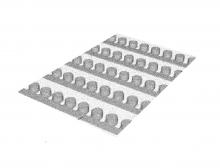BACKGROUND
Spheroids and organoids have been proposed as alternative systems to animal models for testing of compounds for the pharmaceutical or personal care products industry. Some of the advantages they offer are cost and time savings, reduced ethical issues, and potentially more faithful reflections of compound response in humans. However, their broad scale adoption requires consistent reproducibility across spheroid-to-spheroid and batch-to-batch when multiplexing and a high fidelity in structural and functional biomimicry. Limitations in these areas would otherwise mask the treatment of a drug and is thus particular problematic in compound screening applications. Furthermore, a more biologically reflective method to control spheroid/organoid matrix stiffness would also be useful in modelling diseases where the matrix plays a key role (e.g. cancer and fibrosis), and the capability for high-throughput screening would also be advantageous.
TECHNOLOGY
Researchers at the University of Toronto have developed a method of rapidly producing uniformly-sized multicellular aggregates in biomimetic hydrogels using a microfluidic platform (Figure 1) for high-throughput screening of compounds. Using an aqueous suspension containing high-density cells and matrix-forming components, uniformly sized cell-laden droplets were formed in microwells organized in multiple parallel rows. Crosslinking of the matrix-forming components in the droplet led to the formation of cell-laden microgels. Finally, a continuous stream of cell culture media through the supplying channel resulted in the formation of multicellular spheroids. Another key facet of the technology is the use of cellulose nanocrystals and gelatin to form a biomimetic nano-filamentous (collagen-type) hydrogel that closely replicates the filamentous ECM in tissue, and which can be used to model the different levels of matrix stiffness found in fibrosis and cancer and opens the door to personalized medicine using patient derived organoids.
Figure 1. Schematic of the microfluidic device (left) containing arrays of channels each with a number of wells. Formation of spheroids (right) occurs in a four-step process. Organic liquid is flowed through each channel, followed by an aqueous suspension containing cells and matrix components. Cycling a second organic liquid through the channels results in the formation of aqueous droplets containing its constituents. Cross-linking of the matrix components provides the structural framework, while growth of cells upon delivery of cell media results in the full-sized spheroids.
COMPETITIVE ADVANTAGE
- High success of formation (100%) and a high survival rate (90%)
- Spheroids of uniform diameter
- High-throughput production of spheroids
- Spheroids can be released from the microwells for analysis
- Continuous phase can be collected for biological assay
- Hydrogel framework similar to extracellular matrix and has a 20-fold variation in stiffness
APPLICATIONS
- Drug screening in pharmaceutical or personal care products industry
- Research application in academia and industry
INTELLECTUAL PROPERTY STATUS
- National Phase: US, EU, CN, CA (US2020224137A1)
PROJECT STATUS
The microfluidic device has been constructed. Spheroids have been produced using a breast cancer cell lines and patient-derived cells with a cellulose nanocrystal/gelatin supporting framework. Spheroids from pancreatic cells and a breast cancer biopsy have also been generated.





